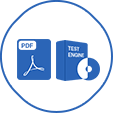Last Update 4 hours ago Total Questions : 332
The Certificate of Cloud Security Knowledge v5 (CCSKv5.0) content is now fully updated, with all current exam questions added 4 hours ago. Deciding to include CCSK practice exam questions in your study plan goes far beyond basic test preparation.
You'll find that our CCSK exam questions frequently feature detailed scenarios and practical problem-solving exercises that directly mirror industry challenges. Engaging with these CCSK sample sets allows you to effectively manage your time and pace yourself, giving you the ability to finish any Certificate of Cloud Security Knowledge v5 (CCSKv5.0) practice test comfortably within the allotted time.
Which of the following is a common exploitation factor associated with serverless and container workloads?
What key activities are part of the preparation phase in incident response planning?
Which method is considered best practice for creating secure virtual machine (VM) images?
Which of the following best describes the concept of Measured Service in cloud computing?
Which of the following best describes a primary risk associated with the use of cloud storage services?
ENISA: “VM hopping” is:
Which of the following BEST describes a benefit of Infrastructure as Code (IaC) in cybersecurity contexts?

